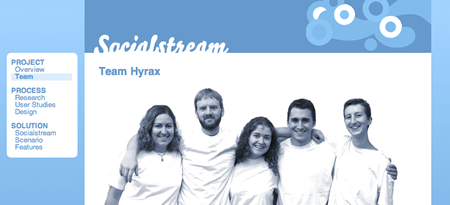The word on the street is that both Yahoo! and Google are prepping for a run at Facebook and MySpace. TechCrunch reported recently on some new social networks in the future by the gorillas. What caught my eye was this part:
Google Operating System is reporting that Google is sponsoring a project at Carnegie Mellon University’s Human-Computer Interaction Institute to “rethink and reinvent online social networking.†The project is called Socialstream.
This was not just Google funding CMU to build the starter kit for their Next Big Thing. It was Google funding a team of master’s students on a capstone project to build the Next Big Thing.
First, the obvious disclaimers. CMU is more established than the IU School of Informatics, which means better reputation in the industry and a longer life in the funding pipeline. One of the world’s most powerful companies writing a check to one of the most respected universities isn’t a connection that would make anyone’s head explode. Second, the HCI grad program there has a different focus, one built around building and traditional usability techniques. In some ways, those students—who have only one year to get a masters degree—are much better prepped to pitch in the big leagues out of the gate.

Team Hyrax, consisting of CMU master’s students, created Socialstream for Google.
Indiana’s view of HCI design is more eclectic and philosophical. We are encouraged to explore new and non-traditional ideas with our inquiry, relying not on following specific techniques as much as a way of discovering the needs of the people who will use the technologies. IU is well-placed due in no small part to the proximity of the HCI group with a world-renown group of complexity and network scientists and cybersecurity experts. Throw in the recent work in massively multiplayer online games, pervasive computing and sustainable design, and our School of Informatics is poised to be a leader in some hot areas of interest.
We are very good at connecting our ideas to real-world need of users. Yet, one thing we aren’t doing well is connecting our projects to real-world practices of business. That means not only supporting efforts to advance projects to alpha stages of development (read: tools that actually function) but also making a regular practice of incorporating the business community in that work. Doing so doesn’t necessitate abandoning not-for-profit partnerships or the pedagogical emphasis on conceptual design, both of which are important parts of this program. It does mean establishing a core set of relationships with businesses able to bring in financial resources and provide avenues for product adoption and future hires.
It is important to note that the CMU team was very well balanced. The teams’ background includes two mathematicians, a social scientist and an MBA. Also four of the five designers had CS degrees. That translates to the ability of the group to handle the technical and financial considerations as well as the creative. I don’t know if it was by happenstance or design, but teamwork here is more often a matter of convenience, self-selection and randomness. I would argue that it is better to have members invested at some high level in a project than to balance skill sets, but there is a cost to short-changing a team with a smaller range of experiences to share.
Take a look at the SocialStream design. They even have a video prototype. It is a great model for any of the projects we do here, in terms of depth of inquiry and evolution of product. Maybe it will inspire some real-world work in other areas.
4 replies on “Where is the Informatics incubator?”
I had created and some of her thoughts about the blogging community she has found herself part of. There are some wonderful comments on that post talking about this sense of community. I also visited Kevin Makice’s blog, BlogSchmog, where he asks, Where is the Informatics incubator? He notes the Techcrunch article about Yahoo! and Google both working on next generation social network tools. Google has partnered with Carnegie Mellon to work on Socialstream. Yahoo! is working on
[…] BlogSchmog » Where is the Informatics incubator? […]
I talked to a bunch of the CMU people at CHI and they all get to work on big projects with high profile clients. Many of them work with google, yahoo, ect and get flown out to California. The work seemed really high profile and I am sure the students got many great connections.
The students I spoke to also felt like cogs in a great machine and that CMU and some of the faculty may not be as engaged in the individual students growth and development as desired.
There has to be some middle ground that allows this program to keep its sensitivities and concept focus while still engaging business, implementation and real-world constraints. The greatest lessons learned at SOI for me have not been how to code but rather how to approach design inquiry. I don’t think that has to go away to be able to find ways for our projects to get a life.